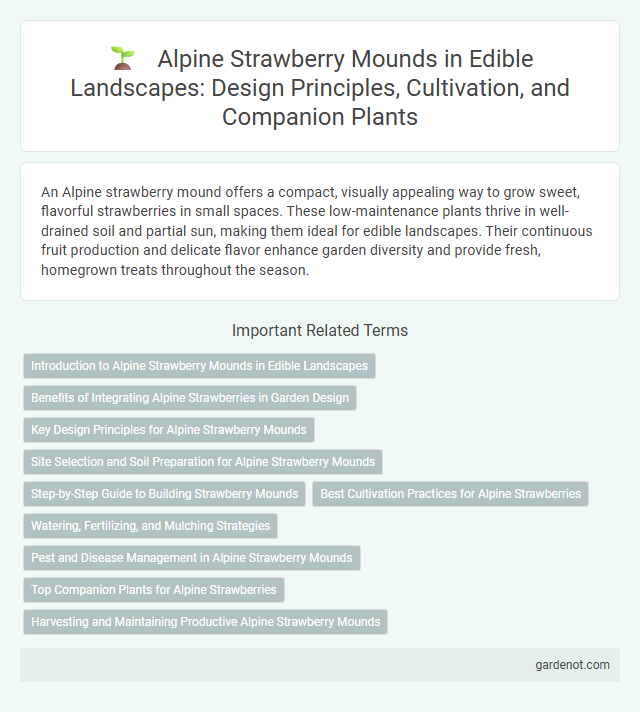An Alpine strawberry mound offers a compact, visually appealing way to grow sweet, flavorful strawberries in small spaces. These low-maintenance plants thrive in well-drained soil and partial sun, making them ideal for edible landscapes. Their continuous fruit production and delicate flavor enhance garden diversity and provide fresh, homegrown treats throughout the season.
Introduction to Alpine Strawberry Mounds in Edible Landscapes
Alpine strawberry mounds create a visually appealing and productive feature in edible landscapes, combining compact growth with prolific fruiting. These mounds enhance soil health by promoting aeration and moisture retention, supporting the delicate root system of alpine strawberries. Their low-maintenance nature and adaptability to various garden settings make them ideal for sustainable, productive edible landscaping.
Benefits of Integrating Alpine Strawberries in Garden Design
Alpine strawberry mounds enhance garden design by providing continuous fruit production with minimal maintenance, thriving in shaded or partially sunny areas. These plants contribute to biodiversity, attracting pollinators such as bees and butterflies, which improve overall garden health and productivity. Their compact growth habit maximizes space efficiency, making them ideal for edible landscapes seeking both aesthetic appeal and functional harvest.
Key Design Principles for Alpine Strawberry Mounds
Alpine strawberry mounds thrive in well-drained, nutrient-rich soil with ample sunlight exposure of at least 6 hours daily to maximize fruit production and flavor. Raised mounds with loose, organic matter enhance root aeration and prevent waterlogging, crucial for the shallow root system of Fragaria vesca. Proper spacing of 12-18 inches between plants fosters air circulation, reducing fungal diseases and promoting healthy growth cycles.
Site Selection and Soil Preparation for Alpine Strawberry Mounds
Choose a site with full sun exposure and well-draining soil to ensure optimal growth for Alpine strawberry mounds. Amend the soil with organic matter such as compost to improve fertility and moisture retention, maintaining a slightly acidic pH between 5.5 and 6.5. Prepare raised mounds at least 12 inches high to enhance drainage and prevent root rot in Alpine strawberry plants.
Step-by-Step Guide to Building Strawberry Mounds
Creating Alpine strawberry mounds begins with selecting a sunny location with well-draining soil enriched with organic compost. Build raised mounds about 12 inches high and 18 inches wide, spacing them 24 inches apart to ensure proper air circulation and root development. Plant Alpine strawberry runners or young crowns on top, water thoroughly, and mulch to retain moisture while preventing weed growth.
Best Cultivation Practices for Alpine Strawberries
Alpine strawberries thrive in well-drained, loamy soil with a pH between 5.5 and 7. Regular watering ensures consistent moisture without waterlogging, crucial for preventing root rot. Incorporate organic mulch to retain soil moisture, suppress weeds, and enhance soil fertility, promoting robust growth and abundant fruit production.
Watering, Fertilizing, and Mulching Strategies
Optimal watering for Alpine strawberry mounds involves maintaining consistently moist soil without waterlogging, ensuring deep hydration especially during fruiting periods. Fertilize with balanced, slow-release organic compost or well-rotted manure in early spring to promote healthy growth and abundant fruit production. Mulching with straw or shredded leaves conserves soil moisture, suppresses weeds, and regulates soil temperature, enhancing overall plant vigor.
Pest and Disease Management in Alpine Strawberry Mounds
Alpine strawberry mounds require vigilant pest and disease management to ensure healthy growth and fruit production. Common pests such as aphids, spider mites, and slugs can be controlled through organic insecticidal sprays and natural predators like ladybugs, while maintaining good airflow minimizes fungal infections like powdery mildew and gray mold. Regular monitoring and crop rotation are essential to prevent soil-borne diseases and sustain the vitality of the edible landscape.
Top Companion Plants for Alpine Strawberries
Alpine strawberries thrive alongside companion plants such as basil, chives, and borage, which enhance their growth and flavor. These herbs attract beneficial pollinators and deter pests, promoting a healthier strawberry mound. Interplanting with low-growing crops like lettuce and spinach also maximizes space and supports soil moisture retention.
Harvesting and Maintaining Productive Alpine Strawberry Mounds
Harvest Alpine strawberry mounds when berries turn bright red and are fully ripe, typically in late spring to early summer for peak sweetness and flavor. Regularly trim runners and remove dead leaves to maintain air circulation and reduce disease risk, ensuring the plants remain productive over multiple seasons. Apply organic mulch around the base to retain moisture and suppress weeds, promoting healthy growth and abundant fruit yield.
Alpine strawberry mound Infographic

 gardenot.com
gardenot.com